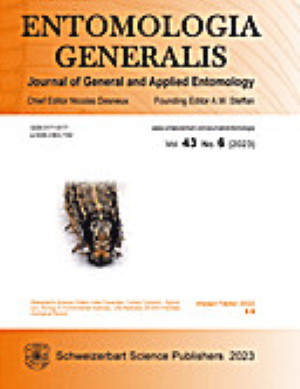在嗡嗡授粉的同花植物上,熊蜂对花的偏好与花的丰度和嗡嗡频率有关
IF 4.6
1区 农林科学
Q1 ENTOMOLOGY
引用次数: 0
摘要
摘要:嗡嗡授粉是一些蜜蜂通过振动花朵来传播花粉的方法。然而,人们对影响蜜蜂偏好嗡嗡叫授粉花朵的决定因素知之甚少。我们研究了熊蜂在高山草甸上嗡嗡叫授粉的五种同花、无蜜的Pedicularis(大戟科)物种,以调查熊蜂对花的偏好对五年间花丰度波动的反应。我们还记录并分析了三种主要熊蜂发出的嗡嗡声频率。我们的研究结果表明,Bombus friseanus和B. lepidus用相似的嗡嗡声频率访问不同的Pedicularis花,并在不同年份表现出与花丰度相关的花偏好。这两种熊蜂在五年中的物候期错开,其丰度峰值出现的时间各不相同。与此相反,花节熊蜂使用较低的基本嗡嗡频率,在不同年份对花的偏好不变,但在不同的Pedicularis品种上使用不同的嗡嗡频率。虽然熊蜂造访后释放的花粉量在不同的Pedicularis物种之间存在差异,但我们发现,熊蜂造访一次后,所有花粉都会沉积在柱头上。我们的研究表明,熊蜂对花的偏好有时(但并非总是)受花的丰度调节,而且至少观察到一种熊蜂在不同植物物种中发出不同频率的嗡嗡声。熊蜂之间对花卉资源的竞争以及同花Pedicularis物种之间对授粉服务的竞争可能会影响植物与授粉者之间的相互作用,并影响物种的共存。本文章由计算机程序翻译,如有差异,请以英文原文为准。
Bumblebees’ flower preferences are associated with floral abundance and buzz frequency when buzz-pollinating co-flowering plants
Abstract: Buzz-pollination is used by some bees to expel pollen through vibrating flowers. Yet, little is known about the determinants influencing bee preferences among buzz-pollinated flowers. We studied five co-flowering, nectarless species of Pedicularis (Orobanchaceae) buzz-pollinated by bumblebees in an alpine meadow, to investigate bumblebees’ flower preferences in response to fluctuations of floral abundance across five years. We also recorded and analyzed the buzzing frequencies produced by the three dominant bumblebee specie. Our results indicate that Bombus friseanus and B. lepidus visited different Pedicularis flowers using similar buzz frequencies and displayed an abundance-dependent flower preference across years. These two bumblebee species had staggered phenologies with distinct timing of peak abundances across the five years. In contrast, B. festivus used lower fundamental buzz frequencies, had a constant flower preference across years, but used different buzz frequencies across Pedicularis species. Although the amount of pollen released after bumblebee visitation varied across Pedicularis species, we found that after a single visit all bumblebees deposited similar amounts of pollen on stigmas. Our study indicates that bumblebees’ flower preferences is sometimes, but not always, modulated by floral abundance, and that at least one bumblebee species was observed to produce buzzes of different frequencies in different plant species. Competition for floral resources among bumblebees and for pollination services among co-flowering Pedicularis species may structure plant-pollinator interactions and affect species coexistence.
求助全文
通过发布文献求助,成功后即可免费获取论文全文。
去求助
来源期刊

Entomologia Generalis
生物-昆虫学
CiteScore
7.10
自引率
18.80%
发文量
72
审稿时长
>12 weeks
期刊介绍:
Its scope covers all aspects of basic and applied research dealing with insects and more broadly with arthropods inhabiting wild, agricultural and/or urban habitats. The journal also considers research integrating various disciplines and issues within the broad field of entomology and ecology.
Entomologia Generalis publishes high quality research articles on advances in knowledge on the ecology and biology of arthropods, as well as on their importance for key ecosystems services, e.g. as biological control and pollination. The journal devotes special attention to contributions providing significant advances (i) on the fundamental knowledge and on sustainable control strategies of arthropod pests (including of stored products) and vectors of diseases, (ii) on the biology and ecology of beneficial arthropods, (iii) on the spread and impact of invasive pests, and (iv) on potential side effects of pest management methods.
Entomologia Generalis welcomes review articles on significant developments in the field of entomology. These are usually invited by the editorial board, but proposals may be sent to the Editor-in-Chief for preliminary assessment by the editorial board before formal submission to the journal. The journal also considers comments on papers published in Entomologia Generalis, as well as short notes on topics that are of broader interest.
 求助内容:
求助内容: 应助结果提醒方式:
应助结果提醒方式:


